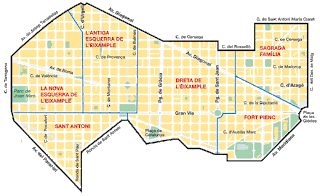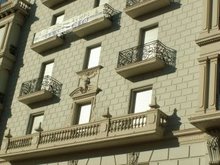
Modern Barcelona was born in the Eixample district. The district is fruit of one of the most splendid moments of history of the city, when it develops as the motor of contemporary Cataluña breaking from its medieval past. The best creative expression of this moment is the modernist arquitectural style, with the edification of many buildings of great value which under the reign of the Sagrada Família, convert it in unique in all Europe. With the local building plan a city was built where there were no differences made between one area and the next and the public services were distributed uniformly between all. This was an ideal district to live in.
Some of the most well known areas of Eixample are Sagrada Familia, Eixample esquerra, Eixample dreta and San Antoni. Famous streets of Eixample are Calle Balmes and Paseo de Gracia. This is now a shopping paradise for locals and tourists alike with many famous shops situated on it. Because of the prestigious shops and hotels it is less residential than before although properties may be found at a reasonable price just afew streets away.
Like most districts in Barcelona it has local markets with excellent produce. It is is great central location although some what noisy due to the volume of traffic.
For details of properties for sale in Eixample please email us at : info@casahomesearch.com
La Barcelona moderna nació en el Eixample, ideada por el ingeniero y urbanista a quien debe su
dibujo mágico y único: Ildefons Cerdà. El distrito es fruto de uno de los momentos más esplendorosos de la historia de la ciudad, cuando se configura definitivamente como el motor de la Cataluña contemporánea y rompe con el pasado medieval derribando las murallas a mediados del siglo XIX. La mejor expresión creativa de este momento es el estilo arquitectónico modernista que impregna el distrito, con una acumulación de edificios de gran valor patrimonial que, bajo el reinado de la Sagrada Família, lo convierten en un conjunto sin comparación en Europa. Con su plan urbanístico, Cerdà diseñó una ciudad igualitaria, donde no se diferencian unos barrios de los otros y los servicios públicos se reparten uniformemente por todos los rincones. Una ciudad para vivir, que evita el amontonamiento de casas tradicional a la vecina Ciutat Vella.


